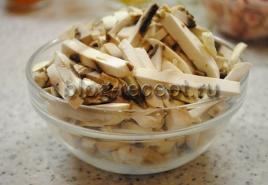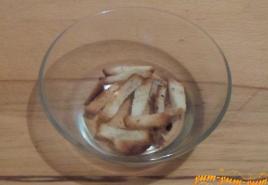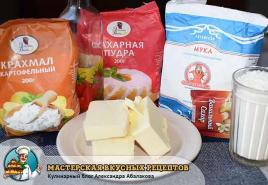Sprouted watermelon seeds when they sprout. Preparing watermelon seeds for planting in open ground. Preparing watermelon seeds before planting in the ground for seedlings
- this is an important stage of work with this crop, which contributes to the accelerated emergence of seedlings after planting. Thanks to such preparatory work, it is possible to accelerate ripening and increase the yield of most melon crops.
Watermelon can be planted in the ground without the soaking procedure. But then you will have to wait longer for the first shoots than for their appearance after preliminary soaking. Moreover, if the region where you want to plant watermelons is in the middle zone or belongs to the north, then soaking watermelon seeds is a necessary procedure.
Of course, whether to soak the seeds of this crop or plant them dry in the ground depends only on the gardener. But, as practice shows, this melon crop needs this procedure. Thanks to it, you can get friendly shoots in a very short time.
How to properly soak watermelon seeds
Soaking watermelon seeds before planting begins with sizing them. To do this, the seeds are scattered on a flat surface and selected depending on their size into small, medium and large. Calibration is necessary so that when planting, sprouts from larger seeds do not “clog” the sprouts of smaller seeds.

Then you need to carefully file the nose of each seed. This will help the sprout quickly find a way out through the thick “shell”. Fans of growing watermelons argue about whether this procedure should be carried out. But everyone agrees that it won’t do any harm.

Before soaking the seeds, they need to be warmed up. To do this, you need to keep them in special containers, gradually increasing the temperature from 15 to 60 degrees. If there are no special containers, then the seeds can be heated in ordinary hot water (50 degrees). Fill it with planting material for half an hour. Then you need to drain the water and wait until the seeds dry out on their own.
Now you can move on to the main procedure - soaking the seeds in order to germinate them.
Soaking watermelon seeds before planting is most often carried out in a solution of potassium permanganate. To do this, they are filled with warm solution for 20 minutes. After which the seeds are washed and can be used for germination.

The procedure of soaking watermelon seeds in a solution of the biological product “Fitosporin-M” has proven itself very well. This solution can not only speed up the emergence of sprouts after planting soaked seeds, but also prevent seedling diseases caused by fungal or bacterial infections.

You can also use potassium humate. This solution accelerates the germination of seedlings by a week and increases the yield of watermelons from 20% to 50%. Fulvic acids and humic acids strengthen the immunity of this melon crop.
How long should watermelon seeds be soaked before planting?
Watermelon seeds prepared as described above should be soaked in water for 12-24 hours. You can find out exactly how long it will take by looking at the condition of the seed. If it has swollen and increased in size, then you can proceed to the germination procedure.

If you want to improve the performance of seedlings, then add aloe juice (20% of the total volume) to the water while soaking the seeds. The juice of this plant is a natural stimulant and will replace artificial stimulants.
Store-bought watermelon seeds can be treated with various compounds. This is indicated on the seed package. Such seeds cannot be soaked. Otherwise, you can damage the protective layer, which can harm not only the shell itself, but also the sprouts even before it appears.

Treated seeds are planted dry. As practice shows, when soaked, seeds coated with a special composition lose their viability by 30%. Soaking such seeds in a solution of potassium permanganate has a particularly negative effect. It may react with the composition with which the seeds were treated, which will have a negative effect on them.

Soaking watermelon seeds before planting is an important, but not mandatory, stage in growing watermelons. In the southern regions, this procedure can be abandoned. But the further north the region where this melon is grown, the more benefits this simple procedure provides.
Watermelon is loved by many people. It’s so nice to refresh yourself with cold watermelon slices or a delicious smoothie on a hot day. This melon crop grows mainly in the south. In regions with hot climates, watermelons grow quickly, and the seeds are planted directly into the ground.
If you want to grow a watermelon in your dacha, don’t worry. Everything can work out for you, you just have to do some preparatory work with the seeds. First of all, you need to learn how to soak them correctly. You can learn about the nuances of this process from this article.

Features of seed soaking
Preparation for growing melons begins long before shoots appear in the garden. Seeds are considered the starting point. If in a hot climate they sprout directly from the soil, then in other conditions watermelon seeds will not survive without preparation. This process is called soaking.
It is not recommended to plant seeds dry. Soaking protects the future plant from diseases, strengthening and disinfecting it. Treated seeds sprout faster, so if you do not live in hot regions, then soaking is a good help for crop germination in a short period of time. Let's look at this process step by step. Correct implementation of each point guarantees a positive result.


Selection of watermelon variety
Today there is a huge range of products on the market different types watermelon Make your choice responsibly. Each variety has its own characteristics regarding not only taste, but also care requirements.
If you are a beginner gardener, choose hybrid varieties. They are the least whimsical and tolerate “stress” better. In addition, hybrids ripen faster than other varieties.
Seed calibration
Purchased seeds must be sorted. Not all summer residents attach due importance to this process, but in vain. The method is simple, but can help you get a good harvest. The fact is that larger seeds usually grow into strong and large shoots. If you plant them next to the weak, the latter will die.
In order for most seeds to grow into good bushes, strong specimens need to be placed next to similar ones, and vice versa.

Spout trimming
Many gardeners practice cutting or filing the spout of each seed. This is done to make it easier for the sprout to break through the thick peel. To do this, literally a millimeter is cut off (cutting off most of it can ruin the sprout inside). There is debate among summer residents about the need for this procedure, but it is reliably known that it certainly cannot cause harm.
Warming the seeds
Before the main soaking, be sure to warm the watermelon seeds. Experts advise leaving them near the battery for a week (at an average temperature of 25-27 degrees Celsius). This method activates biochemical processes in the seeds, which affects the rapid growth and development of future plants.
There is another option. In this case, you need to immerse the bag of future watermelons in warm water for about five minutes. The water temperature should be around +50°C. Then leave the bag to dry for at least two days. The effect is achieved the same as in the first option.

The soaking process itself
After all the work done, you can proceed to mixing the solution and soaking the planting material. Watermelon seeds should be soaked in a solution of microelements. Typically, summer residents use manganese, boron and molybdenum. These substances not only strengthen, but also disinfect the seeds. The concentration of the solution is minimal, it is about 0.05 percent. The container with the seeds is filled with the resulting warm solution.
All kinds of artificial solutions suitable for such purposes are also commercially available. Judging by the reviews, they have a positive effect. Industrial biological products have a principle of action similar to potassium permanganate. They are able to accelerate growth and also protect young shoots from fungal diseases and various bacteria. A solution of potassium humate is popular. It increases the germination of watermelons and increases the yield by 20%.
On average, seeds are soaked for 16 hours, but in each case the approach is individual. As a result, each seed should increase in size and swell.
Periodically look into the saucer (or other container with seeds) so as not to miss this moment.

Germination of seeds
This is the last step of soaking, which will allow the seeds to germinate a little. To do this, place them again for 10 minutes in hot water, and then place them on a gauze bag. To do this, fold the gauze in several layers, after moistening it. Each seed should lie at a considerable distance from each other.
Leave the saucer with the bag in a warm place, moistening it if necessary. Be patient, you should see white sprouts emerging from the seeds. Already slightly sprouted seeds can be planted in fertilized and moist soil.
As already mentioned, the soaking process is aimed at facilitating the germination of shoots in open ground. Such artificial assistance is necessary for melons and melons if the plants are grown in an unsuitable region. In middle and cold climates, all of the above steps are mandatory if the gardener wants to get a harvest.
A long preparation stage is a disadvantage of growing watermelons. In addition, the culture is very demanding in terms of conditions for growth and development throughout life cycle. This is worth considering.


Preparing the soil for planting seeds
From preparing the seeds, you should move on to choosing the site where you plan to plant the crop. There are several requirements to consider:
- good lighting;
- proper fertilizers and plant nutrition;
- no strong wind or draft.
Try to create weather conditions for the crop that are as close as possible to the climate of the southern territories. The sun should warm the soil and fruit well. It is important to avoid frequent gusts of wind; watering is required. It is necessary to fertilize the soil in advance with green manure and minerals, preparing it for planting seeds.
If your seeds are of high quality, then there will be no problems at all. You can plant them in pots without germination. Next, place the pot next to the radiator, so that it is approximately 25 degrees; after 4-8 days, sprouts appear.
If you still want to germinate the seeds before planting, then
- Rinse off the fungicide from the seeds under the tap
- Soak the seeds for 60-120 minutes in warm water (50-60 degrees). It is advisable to place a container of water on the battery.
- Take cotton pads and moisten them with water. Put the change between the disks
- The disc is placed in a plastic lunch bag.
- Next, the most difficult thing is to place the package in a warm place.
The last point is the most difficult; you need to place it so that the temperature of the cotton pads is 28-32 degrees. Can be placed on or next to the battery. If the temperature is above 38 degrees, the seeds will definitely spoil; at temperatures around 25 degrees, they will take a long time to germinate. I recommend buying a heated mat for cats/dogs with temperature control. For example this: http://www.pleer.ru/product_231865_inkor_40x50cm.html
Germination of old, low-quality or triploid seeds
Triploid (seedless) watermelons are a separate issue. The fact is that the growth force of such plants is very small and may not be enough to start. Those. If you take good seeds of seedless watermelons and simply plant them in the ground, then normally they will germinate very poorly. Such seeds need to be given special importance.
There are two ways to increase seed germination
- Bubbling seeds.
For example, this thing http://www.ayurveda-shop.ru/product/prorashivatel-zdorovja-klad. - Soak the seeds in a solution of epin, zircon according to the instructions.
Soak cotton pads with epion/zircon and leave the seeds there for 3-4 hours. Be sure to replace the cotton pads with new ones soaked in water and then put the cotton pads in a bag and in a warm place.
The temperature should be around 30 degrees.
Note.
- You cannot germinate seeds in gauze, as the roots will get tangled in it.
- The temperature during germination should not exceed 35 degrees
- Using the method described above, you can powerfully germinate the seeds of cucumber, pumpkin, tomatoes, peppers, eggplant, beans, and corn.
Since everyone knows from childhood that watermelon is a southern crop, many gardeners do not even try to grow this large berry on their own plot. And in vain, because you can plant watermelons and melon seedlings even in Siberian conditions! The main thing is to choose the right seeds, follow the rules for growing planting material and planting it in the ground, and then you will be able to enjoy self-grown sources of vitamins. Healthy seedlings are the key to a rich harvest, so it is necessary to study all the intricacies of their cultivation.
Before you figure out how to plant seedlings correctly, you first need to grow them. And this fascinating process begins with a trip to the store to select seeds. The first thing you need to do is carefully read the information on the packaging of the variety you are interested in.
Large sweet watermelons can be grown on your own plot
How to choose and prepare seeds correctly
If you do not live in southern latitudes, choose early-ripening varieties with a ripening period of 70-90 days. Typically, seedlings are planted in the ground in May, so late-ripening varieties may not mature. Ask the seller for help and ask what varieties of melons are bought from him most often. If you don’t know much about these cultures, this tip will help you make the right decision. Don’t risk buying planting material just because beautiful packaging.
Among the early ripening varieties, the watermelon “Ogonyok”, “Sugar Baby”, “Kholodok”, “Krymson Sweet” and “Astrakhansky” remain popular. Their ripening period is on average 65-70 days. The weight of ripe berries is 3-5 kg. If we take the popular watermelon “Kholodok” as an example, its fruits, with proper care, will weigh 4-4.5 kg. One such beauty is enough for the whole family to enjoy at dinner.

This is what a ripe Ogonyok watermelon looks like
As for melons, early ground melon is considered one of the favorite varieties. It ripens in 90-110 days and has slightly oval-shaped fruits weighing up to 3 kg. This variety is distinguished by its juicy, dense pulp. Among the quickly ripening varieties, it is also worth highlighting the varieties “Altaiskaya”, “Kolkhoznitsa”, “Pineapple” and “Zolushka”.
It is better to choose seeds that were collected 2 or 3 years ago. If you sow unseasoned seed, the plants will have many male flowers, but female flowers are needed for the ovary.

You need to choose watermelon seeds carefully
After purchasing, you need to prepare watermelon and melon seeds for sowing as seedlings:
- Preparation begins with soaking in a weak salt solution (take 0.5 tsp of salt per 100 g of water).
- Seeds that have fallen to the bottom should be rinsed in clean water and allowed to dry.
- After drying, you need to warm it up for 2-3 hours in water at a temperature of 50-60 degrees.
- Then soak them in a manganese solution for about half an hour. Potassium permanganate will kill microorganisms that came from the soil. In the future, such a simple action can protect seedlings from diseases.
- The last stage of preparation is soaking until the sprouts hatch.

What do hatched seeds look like?
Preparing soil and containers for seedlings
Properly prepared soil for watermelon and melon seedlings is already half the success. You will need 3 parts cow humus and 1 part turf (a layer of soil that is cut off along with the roots of dry plants). The second option is to mix 3 parts of low-lying peat with 1 part of sawdust and 0.5 parts of humus. The last component is necessary so that the soil for seedlings of watermelons and melons has enough useful substances for fast growth.
- the pots are made of natural material;
- peat serves not only as a container, but also as a fertilizer;
- porous walls allow water to pass through quite easily, and air also passes through them;
- roots can grow through the pot without resting against the wall and without becoming deformed;
- The pots are quite durable and hold their shape.

Growing seedlings in peat containers
Frail roots are very fragile, so they can break if transplanted carelessly from ordinary glasses, which can lead to the death of the plant. When the peat pot goes to open ground, it protects the root system of watermelons and melons from mechanical damage. If you have little experience in replanting, use this idea.
Timing for sowing watermelon and melon seeds for seedlings
Even in winter, gardeners begin to wonder when they should plant watermelons and melons for seedlings this year in order to get a good harvest. And this is correct - each region has its own climate characteristics, so updating the forecasts will not be superfluous. Thus, the timing of planting watermelon and melon seedlings in the middle zone and in Siberia differs significantly.
The optimal planting time is the end of March, the deadline is the beginning of April (approximately 27-30 days before planting in the ground). If you plant seeds late, you will miss the time when it is better to plant watermelon seedlings in the ground. There is also a risk that they will not have time to ripen before the beginning of autumn. In mid-latitudes this is very important, because early frosts can ruin the harvest. But in the southern regions a slight delay is not so critical.

Watermelons can be grown even in Siberia
If you are wondering when to plant melons and watermelons for seedlings according to lunar calendar, remember the most important rule - you can’t sow on full moon. The second quarter of the waxing moon phase is considered an excellent time that promises a rich harvest. This is the period when you can plant not only watermelons, but also other fruits with seeds (tomatoes, peas, bell peppers and others).
It is best to plant the seeds in separate cups, but if you plan to do this in a box, maintain a distance of 10-12 cm between the holes. Fill the planting container 2/3 with prepared soil. You can add a little drainage to the bottom. For planting, you should select the hatched seeds, immediately determining at what depth to plant watermelons for growing seedlings.

Better to grow in glasses rather than boxes
If you have a lot of seeds, plant them in pairs at a depth of 3-5 cm. Later, you need to select the stronger one from the two seedlings, and carefully trim the weak one with scissors. You should not pull out a young plant, so as not to damage the fragile roots of the neighboring watermelon that you are leaving. In principle, the depth of planting melon seedlings is the same. Typically, sprouts appear at home in 4-6 days.
How to care for watermelon and melon seedlings at home
Well, the seeds have been planted, now you can start caring for future seedlings. The first thing to do is wrap the pots with stretch film and ensure the correct temperature. Main nuances:
- until seedlings emerge, a stable temperature of 25-30 °C should be maintained;
- after germination, it is recommended to reduce the temperature to 18°C at night and to 20-25°C during the day.

How to properly water melon seedlings
Since melons prefer a moderate level of soil moisture, watermelon and melon seedlings at home should be watered frequently and sparingly. If the soil in the planting pots is allowed to dry out, the plants may become sick. Correcting this oversight will be difficult, because fragile roots are sensitive to the slightest lack of moisture. The same can be said about its excess.
The seedlings should be watered with warm water so as not to cause shock. From watering cold water they weaken and may die. The optimal water temperature is 25-30 °C. If the pots are in a heated room, the seedlings must not only be watered, but also properly sprayed with warm water from above. When growing in a greenhouse, this is not necessary - the humidity level is higher there.

Healthy watermelon seedlings
How to properly feed young plants
To obtain high yields and beautiful fruits weighing more than 2.5 kg, din and watermelons must consume potassium, nitrogen, phosphorus, calcium and sulfur in sufficient quantities. The first feeding for watermelon seedlings at home is necessary at the stage of the appearance of the first true leaf on the plants. Prepare a solution from the following components:
- 15 g superphosphate;
- 6 g of saltpeter;
- 7 g of potassium (take sulfate, not chloride).
Preparation:
- Prepare 10 liters of water with mullein (out of 10 liters of mullein there should be 2.5 liters, that is, one quarter of the volume).
- If there is chicken manure, add that too in a ratio of 1:7.
- Dissolve potassium, saltpeter and superphosphate in the resulting mixture, then feed the plants.

A small package of fertilizer is enough for fertilizing.
This will be an excellent foundation for active growth.
The second feeding is carried out 14 days after the first. The weight of fertilizers indicated above should be doubled. Plants will already be more developed, they will have an increase in the number of leaves, so they will need more microelements to grow. There is no need to buy other fertilizers - two feedings of planting material will be enough.
Possible problems with seedlings and their elimination
Gardeners often do not understand why watermelon seedlings die, because they are trying to create everything for them the necessary conditions. There are several reasons, but the most common ones are worth considering in detail.
What to do if watermelon seedlings die
The first reason for damage to young plants is improper watering during the growing process. Most often this is excess moisture, because many gardeners are too careful about irrigating seedlings and do not allow the soil to dry out at all. Due to excess moisture, the vessels passing through the plant stem are affected. In other words, fusarium develops - a dangerous disease. It is also provoked by low temperature.
If you notice signs of fusarium, you need to remove the diseased plants so that they do not infect healthy ones. Externally, this disease can be identified by the yellow tint of the leaves and the appearance of rot in the root zone. If these signs are detected, do not delay removing the infected bushes - these young watermelons will still not be saved.
To avoid possible problems with young plants, follow a few rules:
- choose disinfected soil for planting, disinfect the tools you will use, especially if they were used on the site;
- maintain a stable temperature in the place where the glasses with the culture are placed;
- protect plants from drafts;
- observe the timing of fertilizing.

Weak melon seedlings
Possible problems with melon seedlings
The reasons why melon seedlings die are also related to watering, temperature and feeding. However, there is another situation that you may encounter in your gardening practice - excessive stretching of stems. Experts believe that this is due to a lack of light on the windowsill or other place reserved for growing seedlings. Duration daylight hours in April it is insufficient, so you need to take care of additional lighting.
To stop the stems from stretching towards the diffused light from the window, install one or more fluorescent lamps. Thus, you will extend the daylight hours to the necessary 11-12 hours for proper growth and development of the crop. Even plants that are located on the south side of the house may need additional lighting.

The plant may be too drawn to light if there is not enough light.
Planting watermelon and melon seedlings in open ground
So, when the seedlings have become stronger, and the temperature outside the window has stabilized and stopped falling below 13-15 ° C, you can safely plant them in open ground. From the day the seeds are planted in peat pots until they are “moved” to the garden, 1-1.5 months pass. Before planting, mark the garden bed to ensure everything is done correctly.
Young watermelons should be planted in a checkerboard pattern, making a distance of 1.5 m between the holes. The depth should be sufficient so that the entire root of the plants is underground, and the cotyledon leaves remain above its surface. If you do not have a very large plot, you can plant seedlings at a distance of 1 m, but not less. To avoid making a mistake, you can watch a video demonstrating the process.
Video: Planting seedlings in the ground
After filling the hole with soil, it should be carefully compacted so that the melon and watermelon seedlings remain in an upright position. To prevent brown rot from spreading in the garden bed, sprinkle a little sand around each seedling. Then water the bed with warm water so as not to injure the plants that are accustomed to the heat. If necessary, provide protection from the scorching rays of the sun until the leaves become elastic.
As you can see, to taste watermelons grown in your garden or greenhouse, you need a little patience and work. Even a beginner in gardening can get a harvest. If questions arise during the process of growing seedlings at home, you can always contact a specialist for advice.
In the southern regions, watermelons are planted with seeds directly into the ground, and in the middle zone this crop is grown through seedlings. In order for seedlings to appear faster, the seeds of watermelons and other melons need to be soaked and processed.
How to soak watermelon seeds?
Some people sow dry seeds in moist soil in seedling containers, but to speed up the germination process it is necessary to process and warm them. Experts advise heating the seeds in warm rooms or near heating devices for 5-6 days, and the air temperature should be about 25-30°C. Using this technique, the germination of seeds and the energy of their germination are increased, the number of female flowers on plants increases, and the vines grow quickly and develop well.
You can speed up the germination of watermelon seeds by pre-soaking them in warm water. Seeds are poured into a canvas bag and then placed in warm water (heated to a maximum of 60°C) for 5 minutes. The heated seeds are removed and then left in a warm room. In room conditions, watermelon seeds are kept for 2 days until sprouts appear. The sprouted (germinated) seeds are sown in heated soil, previously moistened.
In order for watermelon seedlings to be strong and resist diseases, even at the seed germination stage, they can be soaked in solutions of microelements (boron, manganese, molybdenum). You need to make a solution of 0.05% concentration. You can “feed” watermelon seeds with this solution for a maximum of 16 hours. Also, in order to avoid infection by fungal diseases during mass sowing, the seeds must be treated with TMTD (5 grams of the substance are consumed per kilogram of seeds).
Hatched watermelon seeds are sown in separate containers to a depth of 1.5 cm, then the soil is watered moderately. Seedlings are transplanted into a greenhouse or on a ridge when 4-7 true leaves appear on it.
However, not everyone wants to tinker with watermelon seedlings, preferring to sow this crop immediately in heated soil or in a greenhouse. This should be done when there are definitely no frosts, since watermelon seedlings die even with mild frosts. When sowing without seedlings, watermelon seeds must be soaked, unless they have already been treated with fungicide solutions. The soaking technology is slightly different: first, the seeds are immersed in water heated to 60°C for 4 minutes, after which they are immediately immersed in a solution of Cytovit and Zircon (1 ampoule of each substance is dissolved in 2 liters of water). Watermelon seeds should swell, after which they can be sown in holes, laying out several pieces. When the sprouts grow a little, 1-2 strong plants are left, and the rest are cut off with scissors or a knife. Watermelons, the seeds of which have been treated with microelements and heating, grow much faster and produce a full harvest. All these procedures need to be done a couple of days before sowing seedlings or in the ground (greenhouse).







